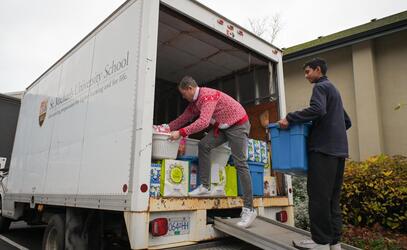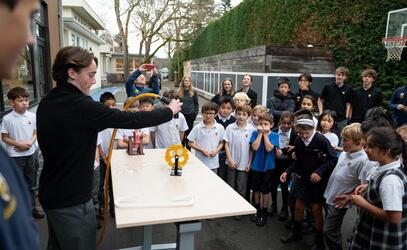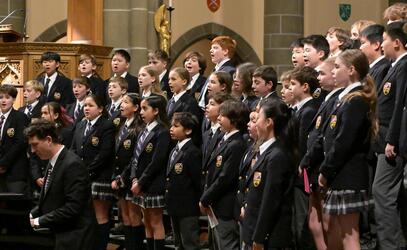Matthew and Kian run through a knee-length field of grass and buttercups toward a lone Douglas fir tree. In each boy's mouth hangs a blue whistle – making a high-pitched noise – with two floppy, white feathers taped to the sides.
They reach the base of the tree and start using grass to shape a bird's nest.
"We chose this place with long grass and a tree so we would be more protected and camouflaged," seven-year-old Matthew says. "I'm an expert on birds and I know that most birds will choose a spot like this so they can blend in with their surroundings so predators can't see them."
The meadow at Beacon Hill Park is a hive of activity with 32 Grade 2 students imitating birds during this outdoor education lesson that blended a game with environmental stewardship to respect the space. The students are using what they learned in the classroom to act out the same steps animals take to successfully find a mate, build a nest, protect an egg from predators and scrounge for food for their chick.
"The purpose of the activity is to reinforce what they've learned about the strategies birds use. But it's even more important that students just learn outside so they can become more attuned to the natural world," says Mr. Jamie Pope, outdoor education specialist at SMUS. "Every little connection they make from a lesson like this will hopefully help them care more about the natural world."
Imagine You're a Bird
To start the lesson, each Grade 2 class lines up across from one another on either end of the meadow.
"On the count of three you can turn around, make your bird call and find the other person who has the same feathers as you," Mr. Pope says. "One, two, three, go! Make your noise, find your mate."
The students run towards each other blowing their whistles and noisemakers in search of the one other classmate making the same sound and holding the same feathers they do. Once they find their mate it's on to building a nest in a predator-proof place.
Matthew and Kian find the fir tree, with its low-hanging, needle-covered branches. Many of their classmates start building their nest in the first place they find – in low grass or out in the open.
Students use the natural material nearby to build large, soft nests with high sides. Then Mr. Pope gives them an egg to protect from predators.
Carrying intimidating stuffed animals – a raccoon and a beaver – Grade 2 teachers Ms. Nina Duffus and Ms. Nicole Tripp test the students' abilities to fend off predators and protect their nests.
Students learned some defence strategies that birds employ: dive-bombing the predator, and pretending to be a weak, injured adult bird to lead the predator away from the nest. The strategies work for some. But the students sitting out in the open quickly learn how easy it is to lose their egg to a predator when their nest isn't camouflaged and has no natural protection.
Once the egg “hatches,” students need to leave the nest to find food for their young.
"Do parents both go find food at the same time?" Mr. Pope asks. He gets an emphatic "No!" in return from all 32 students.
"Exactly, predators might come eat the chicks," Mr. Pope adds.
Students then search for gummy worms in the grass. Mates who leave their nest unattended and don't heed Mr. Pope's advice return to find that their chicks have been taken by predators.
"Ultimately this is just a fun, hands-on activity to help them learn about what birds have to do in real life," Mr. Pope says. "It's just a great opportunity for them to be out in nature."
Outdoor Education at SMUS
Our outdoor education program at the Junior School regularly brings Mr. Pope in to work with teachers to create lessons that go beyond a classroom setting.
"There is great value in having children outdoors and learning from their environment. We noticed there was a need to have some support, just like we want support from someone who has a tech specialty or an arts specialty," says Mrs. Becky Anderson, Director of Junior School. "With the support of Mr. Pope, teachers have really been able to creatively think of real-world links to what they are exploring in class and take the learning outside."
The outdoor education program is a continuum that runs through the Junior, Middle and Senior Schools. At the Junior School, we focus on building connections with nature and ensuring students are comfortable outdoors.
One of the most meaningful ways that's done is by visiting and revisiting the same place throughout the school year. Grade 3 students, for example, walk to McNeill Bay once a week where each student has a "spirit spot" – a spot they chose in September where they sit quietly to observe their surroundings. Students know this location as Chikawich, the traditional L’kwungen name for the area.
"That's a great way to make connections because they become much more aware of the animals that live there, the tides and currents in the oceans, the weather patterns, the plants and how they change throughout the year," Mr. Pope says. "And with knowledge comes connection. If a student learns during the year that the rock they're sitting on is a granitic rock that came from Squamish on the back of a glacier, that goes a long way in terms of them feeling connected to that place."
Through the later years of Junior School and into the Middle and Senior Schools, outdoor education becomes more about learning skills – from outdoor skills like fire-building and first aid to leadership skills like communication and resilience.
The outdoor education program culminates in the formal outdoor leadership program in Grade 12, where participants work with students in younger grades to help them build their own skills.
Bringing Learning to Life
Grade 2 students spent the last couple of months in class learning about life cycles of different living beings. The classes hatched 26 chicks and six ducklings, and there are currently 60 caterpillars becoming a chrysalis in the classrooms that will soon emerge as butterflies.
"It's so important that students get to see these animals and insects in their natural habitats. The classrooms are good learning environments but it's an artificial experience. When we're out in nature it makes the learning real for them, it brings it home," says teacher Ms. Nina Duffus.
After building the nests, protecting their young and foraging for food at Beacon Hill Park, the students sit together in the field to share what they learned from their experiences as birds.
Mr. Pope asks questions about what students discovered about the shape of the nests ("It needs high sides so the egg doesn't fall out," Zoe says) and nest location ("Kian and Matthew's was good because they built theirs way over there in the tall grass under the tree and they didn't get many predators," Rhys says).
Mrs. Anderson says bringing Mr. Pope's outdoor education knowledge into the learning environment has had a noticeable impact on the students.
"When the students come back from an outdoor experience it's all rosy cheeks and big smiles. I love seeing how much they love it and how much they learn in nature," she says. "We are so lucky to live somewhere where we can enrich their education by creating these amazing learning experiences in the natural world."


